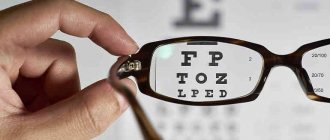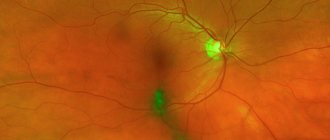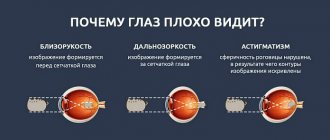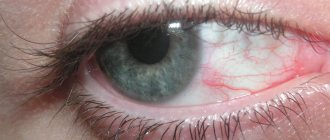Differences between myopia and farsightedness
With farsightedness, a person sees objects located nearby blurry, it is difficult for him to read text and work with small details, but he clearly and clearly distinguishes objects at long distances.
With myopia, on the contrary, near vision is characterized by high quality, but objects at a distance become blurry. Myopia and farsightedness also differ in that myopia is most often caused by a genetic predisposition and manifests itself in early childhood, while pathological hyperopia (as opposed to physiological hyperopia, inherent in all people at birth) usually begins to develop after 40-45 years (age-related farsightedness) . This is an inevitable process for all people.
What is myopia
Myopia (or myopia) is a vision disorder in which objects at a great distance appear blurry, while close objects appear clear. This is due to the fact that in a myopic eye the image is focused in front of the retina, and not on it. Nowadays this is the most common vision pathology.
Human eyes are designed to distinguish objects at a long distance. In our age of technological boom, people, on the contrary, constantly strain their eyes by looking at objects at close range. In this regard, it is believed that a third of the world's population suffers from myopia. Myopia occurs due to elongation of the eyeball or increased refractive power of the eye cornea.
How do nearsighted people see? Objects that are in the distance appear blurry, but when approaching they become clearer. In this case, rapid eye fatigue, headache, pain and pain in the eyes are possible.
The structure of the eye with farsightedness
With this pathology, the optical focus is not exactly on the retina, but behind it. There may be several reasons for this:
- shortened size of the eyeball. Normally in humans, this organ has a diameter of 23-25 mm. If its size is too small (19-22 mm), the focus “goes” behind the eye, bypassing the retina;
- the cornea is too flat and has low refractive power;
- displacement of the lens forward, which leads to improper focusing of light rays. He is forced to constantly strain to concentrate on an object nearby;
- abnormalities of the lens: microphakia (too small), aphakia (complete absence of the lens), or the placement of this natural lens in the wrong place (displacement).
Physiological farsightedness is inherent in all people at birth. The baby is born with a slight degree of hypermetropia of approximately 2-4 diopters. This is explained by the fact that the visual organs of a newborn are not yet fully developed, and the size of the eyeball is only 17-18 mm. As a child's body grows, so do the eyes.
Farsightedness is much more difficult to recognize than myopia, especially with weak and moderate degrees. In fact, our eyes themselves fight hyperopia by constantly straining the ciliary muscle, which allows a person to see objects equally well at different distances. But by the age of 40-45, when the muscle weakens due to age and is not able to work at full strength, presbyopia, also called senile farsightedness, appears.
The main changes in the eyes with presbyopia occur in the lens. Its age-related degeneration begins: it becomes inelastic, the core becomes denser, and accommodation decreases. As a result of such transformations, the lens loses the ability to increase the radius of curvature when viewing closely located objects, and they have to be moved further and further from the eyes.
With severe degrees of farsightedness, blurred vision is diagnosed both near and at very far distances, and with this form of hyperopia there is a risk of developing glaucoma.
Too short an axis or forward displacement of the lens can lead to partial blockage of the drainage pathways through which intraocular fluid is drained, which increases pressure in the eyeball and increases the risk of glaucoma.
Unlike farsightedness, with myopia, on the contrary, the eyeball has an increased size, and there are two types of myopia. If the ocular axis is elongated - the distance from the edge of the cornea to the retina, then such myopia is called axial. If the cornea has an overly convex shape, then light rays are refracted too much, and this type is called refractive myopia. Usually they are combined with each other.
Myopia poses a greater risk to eye health than farsightedness. This disease begins to develop, as a rule, with the beginning of school, when the child’s visual load increases sharply. At the same time, his body is growing rapidly, all organs, including the eyes, increase in size.
https://www.youtube.com/watch?v=ytcreatorsru
Too sharp growth along the anteroposterior axis may be accompanied by disturbances: the retina is stretched due to an enlargement of the eyeball, and this can lead to its detachment or rupture. During this period, it is important for parents to pay attention to the state of the child’s vision and, if there are alarming symptoms, contact an ophthalmologist. Successful correction and treatment of myopia depends on timely diagnosis.
In the presence of this pathology, it was previously forbidden to give birth naturally, since at the time of birth intraocular and blood pressure increases greatly, and the eyes experience great tension, which often leads to rupture or detachment of the retina. Nowadays, pregnant women with high degrees of myopia undergo laser coagulation of the retina, which allows it to be strengthened and firmly connected to the choroid, so there is virtually no risk of damage.
In childhood, the only eye surgery allowed to stop progressive myopia is called scleroplasty. A small strip of biological tissue is attached behind the eyeball, which strengthens the sclera and prevents it from stretching. However, no method provides an absolute guarantee of stopping the development of myopia.
Myopia (myopia)
Causes
The direct anatomical cause of myopia is most often a disproportion between the longitudinal and vertical dimensions of the eyeball (this kind of disproportion occurs very often; an exception can be considered, rather, an anatomically correct shape, but the compensatory capabilities of “eye optics” are still quite large, and deviation is not always from the ideal has a noticeable effect on visual acuity).
This was first proven back in the 17th century, in particular, by the works of Johannes Kepler, then Vopiscus Plempius and others; in addition, Kepler geometrically substantiated the correction of myopia with biconcave (“minus”) lenses. Clearly distinguishing distant objects requires a flatter lens shape and lower refraction, but when the eye is significantly elongated along the longitudinal axis, the combined optical power of the cornea and lens is too great to project the focal plane accurately onto the retina: the focus shifts anteriorly. To the same situation, i.e. Some other reasons also lead to the focusing of the image in front of the retina, instead of projecting exactly onto it, for example, keratoconus (deformation of the cornea in the form of horizontal stretching) or a transient spasm of accommodation (the inability of the ciliary muscle to completely relax after prolonged stress, the so-called false myopia). True myopia, in addition, can be caused by abnormally high refractive indexes of the intraocular optical media - when, even with the correct shape of the eyeball, the light flux is refracted more strongly than is necessary for clear distance vision - but such an anomaly is much less common than geometric disproportion.
In turn, longitudinal elongation of the eyeball can be caused by weakness and extensibility of the tissues of the sclera (the opaque white “body” of the eye), caused by heredity, constant overload and weakening of the accommodation mechanism, infectious and inflammatory processes, hormonal imbalance, metabolic disorders, vascular disorders ( blood supply), ophthalmic trauma, age-related changes (myopia of the elderly), etc.
In general, the question of the causes of myopia remains open; it is not as simple as it might seem. One of the most authoritative ophthalmological journals published the results of a study (“Clinical and Experimental Optometry”, Sivak & Jacob, 2012), according to which most of the hypotheses put forward at different times do not find sufficiently convincing confirmation. At the same time, reliable risk factors include region of residence (in some Asian countries the overall prevalence of myopia reaches 70-90%, in Europe and the USA 30-40%, in Africa 10-15%) and ethnicity (in people of Semitic origin You're about twice as likely to develop myopia)—in other words, genetic factors definitely have an influence. There is also no doubt about the importance of factors associated with the environment and lifestyle: unbalanced nutrition, hypovitaminosis, environmental and occupational hazards, general physical inactivity, a huge number of medications taken for various reasons, non-compliance with hygiene and vision safety rules (optimal lighting and distance, breaks in reading , exercises for relaxation of the ligamentous-muscular system), endless monotonous contemplation of all kinds of screens, especially small ones and at close range, smoking, etc.
From approximately the middle of the twentieth century to the present day, there has been a steady trend toward an increase in the incidence of myopia in the general population.
Eyes with simultaneous myopia and farsightedness
It also happens that a person has myopia and hypermetropia at the same time. This may occur due to the following factors:
- curved shape of the cornea;
- presbyopia;
- presence of astigmatism;
- disorders in the visual center of the brain and others.
In the case of presbyopia, the elasticity of the eye lens decreases and its ability to accommodate decreases. With the development of age-related farsightedness against the background of slight myopia, this happens unnoticed by a person, but with high degrees of myopia, one has to wear either two pairs of glasses or complex multifocal contact lenses, since vision is blurred at different distances.
Astigmatism can be myopic, hyperopic and mixed, when a person has myopia and farsightedness. Most often, they occur in different eyes, but in case of complications, these defects can be observed simultaneously in one of them.
With astigmatism, the eyes quickly get tired, as they are under constant tension. It is best to get rid of it with the help of microsurgical operations that will restore clarity of vision near and far.
What's the salt?
The essence of myopia is that a person’s eyeball becomes oblong. As a result, the optics are damaged. The image in a myopic eye is focused in front of the retina, and not on it, and the person begins to see the world around him in the distance blurry, as if the focus of a camera is off. The higher the degree of myopia, the more blurred the picture is, even at close range.
But not only heavy loads can lead to negative vision. For example, the eye muscle may be weakened, the lens may be damaged due to injury, and, of course, there will be no age-related changes. Plus genetics. It is impossible to protect yourself from myopia 100% - this is how our body works.
Causes of myopia
Heredity is one of the main causes of myopia. Only 8 percent of children whose parents suffer from myopia do not have vision problems. Another significant reason is excessive visual stress. Constant observation of nearby objects, insufficient lighting, incorrect posture - these are all the reasons for the appearance of myopia. This problem has become especially acute in recent years with the introduction of all kinds of mobile gadgets into everyday use. Other causes of myopia can be: incorrectly selected glasses or lenses, eye injuries, age-related changes in the lens, transformation of the cornea.










